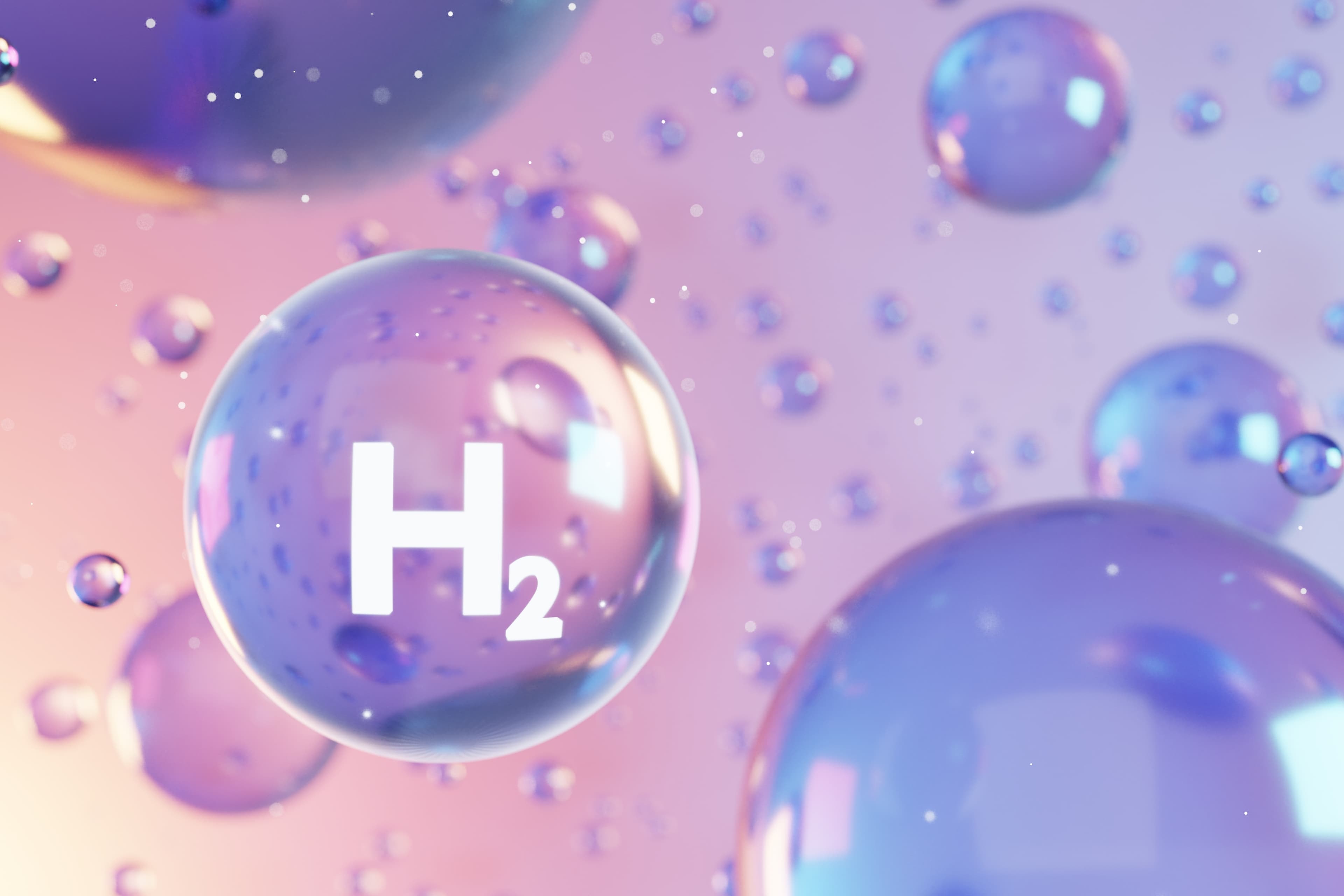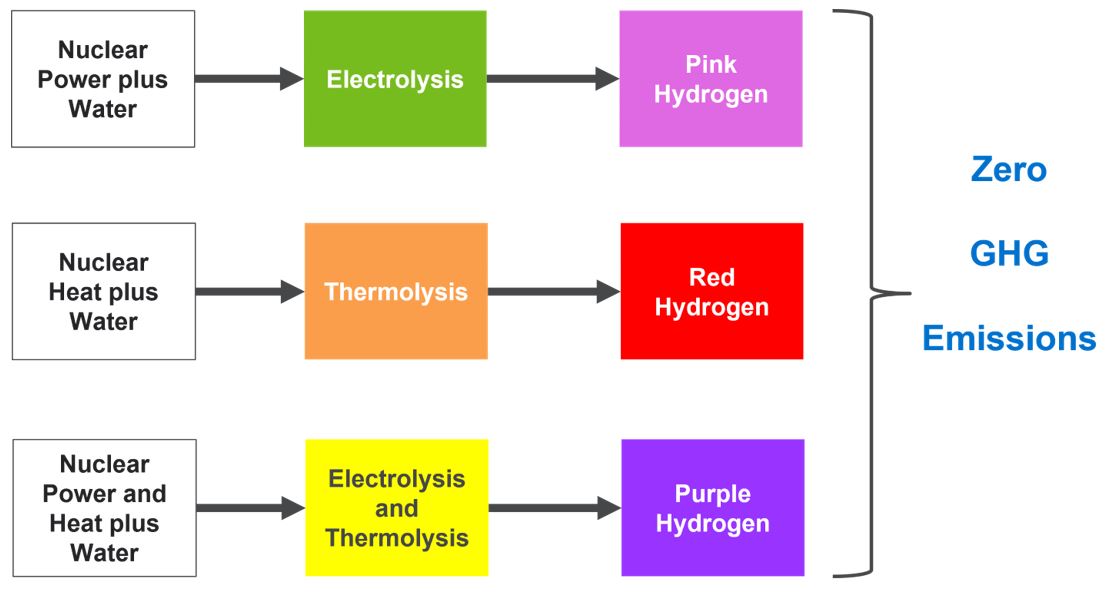Decarbonization pathways via pink, red, and purple hydrogen

Global stakeholders and policymakers are targeting “net-zero” emissions by 2050 for constraining global temperature rise to 1.5 to 2.0 degrees Celsius (°C). Accordingly, many programs and projects for producing low- and zero-carbon hydrogen are planned, proposed, and under development. Hydrogen is the lightest and the most abundant element in the universe. Hydrogen gas can be stored, transported, and utilized for various end-use applications. Unlike most feedstocks and fuels, hydrogen does not emit carbon dioxide (CO2) when combusted but produces water. Hydrogen is typically used in the chemical industry for several important chemical products such as ammonia, methanol, cyclohexane, hydrogen peroxide, aniline, and oxo alcohols, amongst others. Hydrogen is also utilized, via hydrogenation process, in the hydrocarbon refining r to decrease the sulfur content of fuel streams as well as in many other industries.
In recent years, hydrogen has emerged as an energy carrier with key benefits over electricity in applications where a chemical fuel is required. As global industry seeks to decarbonize transportation and industrial processes, the versatility of hydrogen-based fuels creates many technically feasible and economically viable opportunities to displace fossil fuels and feedstocks in different parts of the economy. Hydrogen can also provide long-term energy storage for the electric power sector, fuel for heavy duty transportation, and heat for industrial processes requiring high temperatures such as steel or cement production.
Current Predominant Colors of Hydrogen
Since elemental hydrogen is rare, hydrogen must be produced from other compounds. For this reason, not all hydrogen is created “equal” for the climate. Hydrogen production can have a large greenhouse gas (GHG) environmental footprint depending on how it is produced. Currently close to ~95 percent of hydrogen production is from fossil-based fuels and feedstocks such as natural gas and coal. The ~74 million tons of hydrogen produced each year emit ~830 million tons of CO2 annually. The color spectrum of hydrogen details how the hydrogen supply/value chain is derived.
Black and brown hydrogen (via coal), and grey hydrogen (via natural gas/methane) are the lowest levelized cost of hydrogen (LCOH) routes and pathways to produce hydrogen by stripping hydrogen from fossil fuels. However, the byproduct of these processes releases vast amounts of CO2 plus fugitive methane emissions into the atmosphere. Blue hydrogen uses natural gas/methane with carbon capture and storage. Green hydrogen is based on electrolysis process wherein electrical currents run through water and breaks it into elemental hydrogen and oxygen and the electricity must be derived from solar power, wind farms, or another renewable source for the hydrogen to be considered green. Turquoise hydrogen utilizes methane pyrolysis (high temperature thermal decomposition in the absence of oxygen) to produce hydrogen and solid carbon from natural gas/methane.
What are Pink, Red, and Purple Hydrogen
As illustrated in the Figure, in principle, zero GHG emissions are achieved via production of pink, red, and purple hydrogen. Pink hydrogen is produced based on electricity from commercial nuclear power plants and water utilizing electrolysis process. Red hydrogen is produced based on nuclear heat and water utilizing thermolysis process. Purple hydrogen is produced based on nuclear power, heat, and water utilizing both electrolysis and thermolysis processes.
Figure: Overview of Pink, Red, and Purple Hydrogen Production
Overview of Pink, Red, and Purple Hydrogen Production - NexantECA
Currently, nuclear power generation, electrolysis and thermolysis are commercially advanced and proven technologies and processes. In addition, nuclear power generation provides continuous duty and baseload power supply/delivery with zero GHG and fugitive methane emissions from fossil fuels as well as intermittency from variable renewable resources such as solar PV and wind energy.
Overcoming Barriers, Hurdles, and Challenges
Based on the ongoing energy crisis worldwide, commercial nuclear power generation is being revisited by various stakeholders and policymakers as a feasible and viable source of zero-carbon electricity. Based on past nuclear power generation incidents and accidents such as Three Mile Island (US) and Fukushima (Japan), key barriers, hurdles, and challenges must be addressed and overcome:
Production of hydrogen in light water reactors (LWR) during the nuclear fission process based on uranium fuels roads immersed in LWR – requiring complex hydrogen recombining systems
Overcoming lengthy permitting and regulatory approval process, high-cost overruns in total installed capital costs (Capex) and high operating costs (Opex) – all resulting in higher levelized cost of electricity (LCOE) during the plant economic life
Processing, long-term safe and secure storage and disposal of onsite solid, liquid, and gaseous radioactive wastes from LWR power generation plants
Ensuring risk mitigation related to effective reprocessing of spent uranium fuel rods
Major industry efforts are being made with respect to advanced LWR designs as well as development, demonstration, and scale-up of small modular reactors (SMRs). Revisiting prior stakeholder efforts with fast-breeder reactors with respect to direct reuse of spent fuel may help to reduce and mitigate current problems with the high volumes of radioactive wastes and spent fuel. Utilization of thorium as the primary fuel for the nuclear fission process in SMRs can enable in overcoming inherent challenges with uranium fuel rods in LWRs. Also, efforts are being made in improving reliability, availability, and maintainability for extending economic lifespans beyond the present 60 years (maximum) and replacing aging LWR power plants with new advanced LWR designs and SMRs.
Summary and Conclusion
Advanced safe technologies and processes, improved costs and techno-economics with respect to Capex, Opex, LCOE, and LCOH are key factors in ensuring continuous, baseload, and secure energy supply from nuclear generation plants. Pink, red, and purple hydrogen are technically feasible and economically viable sources of zero-carbon fuels, feedstock, and energy carrier based on nuclear power integrated with commercially advanced electrolysis and thermolysis processes.
The Authors…
Pat Sonti, Senior Consultant
Babul Patel, PhD, PE, Principal
